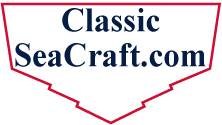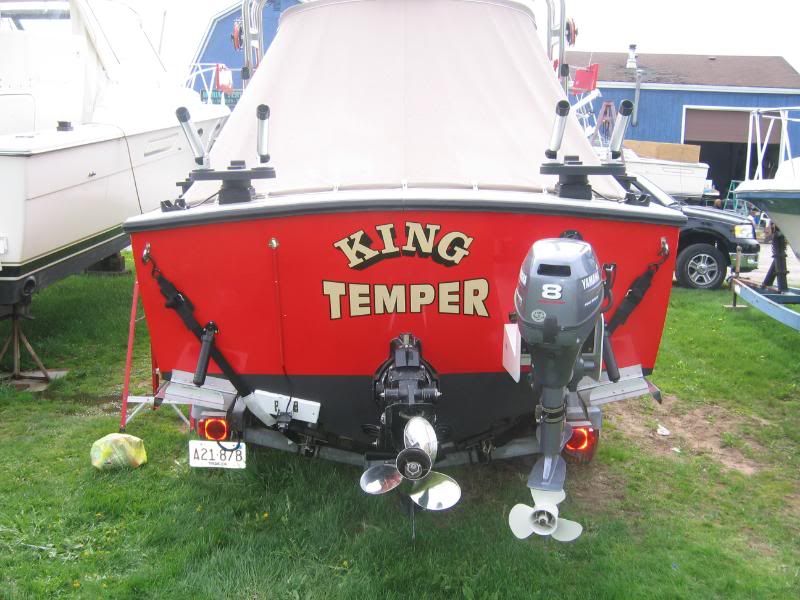
 |
|
#21
|
|||
|
|||
|
That's a sweet setup. I'm jealous.
It seems like the only issue you will have will be keeping an eye on the risers. Does that motor turn 325 horses? |
|
#22
|
|||
|
|||
|
Quote:
Quote:
 Quote:
Dave
__________________
Blue Heron Boat Works Reinventing the wheel, one spoke at a time. |
|
#23
|
|||
|
|||
|
Quote:
i have not seen one of those "seacore" engines - heard about them,but not seen. the merc engines have a "dry joint exhaust system - meaning,no water is pumped through the mount point where the riser meets the mainfold - pretty durable set up - haven't seen any failures from them... only problems i've seen - is the water pressure sensors - back of the engine- power steering cooler,is where it's located - seen a few of these go bad...other than that - nothing... my own rig,it's got a 5.7mpi,horizon engine - it's an older engine - '02,and it's been 100% trouble free - it's got just about 500hrs on it...i've used quite a few of these on repowers,in both stern drive applications and inboard systems - all with similar results... make sure you "wheel" that engine,so it just about "bumps" the rev limiter... the bravo drives,they're a very good drive,very durable simple basic maintance on them... i have not seen a bravo III drive,since the update,with any kind of corrosion problems - one client of mine has a crowneline,BIII drive - it's an '06 - no corrosion anywhere - it's a slipped boat... side note:antifouling paint - you really should have a gap,of 1" around the perimiter of the transom assembly,where there's absolutley no paint - leave that area clean - failure to follow this,can result in a galvanic reaction,between the copper based antifouling paint and the aluminum transom plate...
__________________
do not let common sense get in your way |
|
#24
|
|||
|
|||
|
Thanks for the good advice. I may have some more questions for you when I start installing outdrive and engine.
Quote:
http://www.mercurymarine.com/media/m...nformation.pdf Don't know if it's still available. Dave
__________________
Blue Heron Boat Works Reinventing the wheel, one spoke at a time. |
|
#25
|
|||
|
|||
|
Quote:
merc offers no carb'd new motors
__________________
do not let common sense get in your way |
|
#26
|
|||
|
|||
|
Great info.
I also have a stern drive on my Tsunami,and also on my last boat.The whole sterndrive bashing is kind of like the bashing Bayliner took.Most of it is done by people who never owned either a stern drive,or a Bayliner. No doubt that in salt water stern drives require more maintenance,and proper care needs to be given to the drive.Because of the salt corrosion problems parts may need to be replaced more often,and you can't tilt the drive completely out of the water like an outboard. I'm ten years into pretty hard use with sterndrives,and can count on one hand,any problems that required any serious work. Like anything else you have to maintain them,bellows need to be inspected and changed periodically,gimball bearings need to be greased properly,as well as the u-joints.Exhaust manifolds need to be changed occassionally,especially in salt water.In fresh water they last for years and years. I know that most of the members on this site are salt water boaters,but on the great lakes where guys like me and Floorboy fish,I/O's(and inboards) are much more common.I like the big high transom when we're fishing in snotty stuff and the waves are rolling up the rear.I also like the open transom for netting fish(we only troll),nothing in the way. I also like the fact that I can do almost all the work myself,as it's a simple 350 GM engine.I don't have to worry about a computer or printed circuit crapping out and not being able to fix it myself. Even the drive doesn't require a rocket scientist to work on it,and even if it blows up,companies like SEI make great good quality after market drives for cheap money. I guess if I was fishing the salt,and I had to decide on a power package,I'd go with outboard power.But,I wouldn't be scared off from going with a fresh water cooled I/O. I can't even begin to imagine what it costs to fix a modern four stroke outboard,never mind trying to fix it myself.I shiver just looking at it when the cover is off.They are a marvel of engineering and nice,but way beyond my skills. Both have their pros and cons. 
__________________
All this,just for a boat ride Last edited by bigeasy1; 11-23-2011 at 12:40 PM. |
|
#27
|
|||
|
|||
|
"It's a simple 350 GM engine"
My primary reason for preferring an I/O. If a problem develops, that old style car engine will warn you well before it quits, almost every time. The rest of the time, a good set of spares and some repair knowledge can get you home from way way out in the boonies. Last edited by cdavisdb; 11-23-2011 at 12:44 PM. Reason: clarity |
|
#28
|
|||
|
|||
|
THX ! Some great advice.
I have a 1975 23' with a 2003, 350 300HP MAG MPI - freshwater cooled manifolds and dry joint risers - with a Bravo 3. Awesome set up. Incredible power. Great response. Fair on fuel consumption. Saltwater run and in water for 7 months. There is more maintenance on the drive than any other outboard I've owned. That's if you like things to be 'right' which I do. During each boating season, while in the water, I must do a barnacle scrape from all the exposed metal parts and a few of the drive areas. This is done 2-3 times a season. The transom mount, the gimbal and the drive need to be sanded pretty well each season to remove the loose antifouling paint and random barnacles, then I will prime any exposed metal areas with primolux and then trilux ( not the spray - I brush it on from the can - a flux brush gets in to the crevices in the mount ). This has enabled me to keep my drive, gimbal and mount - MINT! each season. It's a decent amount of work but I feel worth it. Probably 6-8 hours a season As for corrosion, I epoxy/barrier coated my SS trim tabs and anti foul them - this helped to reduce the amount of NOBLE metal in the water a lot. I keep the mercathode in as best shape as I can, it's tough to clean the element without damaging it. I do all my own maintenance and the one jobI want to tackle is the bellows. Never did this project before - I do hear it is difficult at best - a real 'hand-bleeder'. In a perfect world, I'd have a 4 stroke Yamaha outboard. IMHO - it can't be beat. No metal exposed to the saltwater for 7 months... |
|
#29
|
|||
|
|||
|
Quote:
pressure washing,usually takes off any loose antifouling paint... if your power set up is "fair" on fuel consumption - i suggest you take a look at the prop on the boat - make sure that engine is just about "bumping" the rev limiter,with the boat loaded,in the way it's normally ran,and full throttle - if the engine's running overloaded - not reaching it's reccomended rpm,it's gonna consume way more fuel than it needs to... trilux is the best product - it's formulated for use on aluminum
__________________
do not let common sense get in your way |
|
#30
|
|||
|
|||
|
Agreed. On a new drive - and I HATED to paint it the first time, I would use a Green scotch scrubber. But, once you have painted it, you can use either or. Either way, I'm not talking aggressive sanding - light with 120 or so - I want to remove the oxidized paint. Where metal shows, I sand it to bright aluminum so the primer has a better chance to stick.
When you paint a never before painted drive with antifouling - no matter how you prep it, there will be areas that will come off in 'sheets' - 1/2" or so after a season... These need to be feathered and a scotch pad ain't gonna cut it. Whenever possible, don't use sandpaper, but at some point, it will be needed. |
 |
|
|